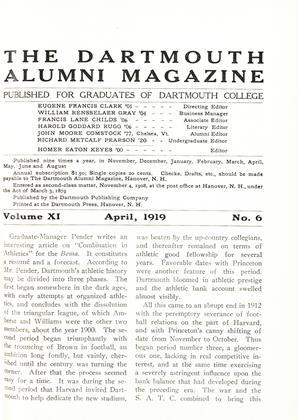Within the past year the College has been the recipient of several interesting Webster portraits. In some ways the most important of these is a profile representation painted in oils by Chester Harding, which came to the College in May, 1918 in compliance with a provision in the will of the late Charles J. H. Woodbury of Lynn, Massachusetts, a recipient of the degree of Doctor of Science at Dartmouth in 1908. The portrait is similar to another Harding in the possession of the College and represents a profile, head and shoulders of the great statesman. Its authenticity is, however, fully attested, which places it in a category apart from most of the portraits attributed to the facile Harding. The picture hangs in the Secretary's office in Parkhurst Hall.
Another interesting Webster portrait is one that was given to the College recently by H. H. Blunt of the Class of '97. The work is undoubtedly that of Joseph Ames, famous for many representations of Webster, all fluently painted and all expressive of dignity and romanticism interestingly combined. The history of the Ames portrait is not fully known. It is highly reputed and has been on public exhibition in Worcester. Mr. Blunt purchased the painting at a Boston auction. It is in good condition and the figure shows few, if any, traces of damage through age or mishandling. The background would seem to have been repainted by a subsequent hand. This portrait, which is something more than half length and life size is now; hanging in the Treasurer's office in Parkhurst Hall.
There is now in the office of the Superintendent a painting of the head and shoulders, only, of Webster, of heroic size and majestic mien. It is a recent gift of Miss Stella O. Libbey of Jamaica Plain, Massachusetts. The artist is unknown, but the portrait had been in the Libbey family for more than half a century before its presentation to the College. The painting has no great suavity of handling, but is essentially vigorous and is, on the whole, more realistic and less romantic than are many Webster portraits.
Curiously enough, the most romantic Webster in the possession of the College and that shown in the frontispiece of this number is one taken from life, or rather an enlargement of a daguerreotype taken from life. For this picture the College is indebted to Doctor H. Sheridan Baketel. Like the Harding portrait it hangs in the office of the Secretary in the Administration Building. A reproduction of it is offered in this number of the MAGAZINE. Just when the daguerreotype was taken is not known, but it was evidently in Webster's younger days, possibly contemporaneous with the famous "Black Dan" portrait by Alexander now owned by the College. Here we have Webster, not primarily the orator or statesman, but the dandy. Such a hat as this could hardly be found in the annals of portraiture since the days of Hans Holbein. Indeed the whole portrait in its jaunty elegance, its exactitude of composition and its subtle refinement of modelling has something quite suggestive of sixteenth century quality. To most persons, however, it will appeal because of its intimate revelation of Webster as a delightfully picturesque human being instead of a demi-god.
 View Full Issue
View Full Issue
More From This Issue
-
 Article
ArticleMILITARY NEWS
April 1919 -
 Article
ArticleANNUAL MEETING OF THE DARTMOUTH SECRETARIES ASSOCIATION
April 1919 -
 Class Notes
Class NotesCLASS OF 1899
April 1919 By George G. Clark -
 Article
ArticleMORNING SESSION
April 1919 -
 Article
ArticleDINNER SESSION
April 1919 -
 Article
ArticleGraduate-Manager Pender writes an interesting article on "Combination in Athletics" for the Bema.
April 1919







